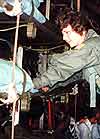Deny and Delay
|
“If you have a contagious disease that is brought back from a war and it’s slowly penetrating into the population, don’t you think that’s alarming?” asked Garth Nicolson.
U.S. Representative Christopher Shays (R-CT), vice chair of the House Committee on Government Reform, is among those who believe that government officials responsible for helping Gulf veterans have pursued a strategy to deny the existence of illness and to delay effective action — a course similar to that followed for so many years with Vietnam veterans exposed to Agent Orange.
“It’s just amazing to think it would be true, but I think it is,” he told Freedom. Rep. Shays has encountered veterans who have been told by VA staff that their problems are all in their heads, and that they should handle those problems by taking drugs.
“They have wanted it to be a mental problem, and in some cases it is, without recognizing that there’s a physical cause for that mental challenge,” he said. Studies have shown physical changes in the brain common to Gulf War veterans, he said. “That’s not post-traumatic stress disorder. This is literally a change in the chemical makeup of the brain unique to Gulf War veterans who have serious physical symptoms....”
“What Were They Doing with These Insect Cages?”
Katherine Murray Leisure, M.D., worked at a VA medical facility in Lebanon, Pennsylvania, and personally examined hundreds of Gulf War veterans. There she observed an epidemic and listed symptoms that seemed common to all. Her primary concern is the high rate of veterans who were burdened with leishmaniasis. By her estimate, “one-third to one-half of seriously ailing Gulf War veterans with ‘unexplained illnesses’ and the... Desert Syndrome we saw in the 1990s had one of several forms of leishmaniasis.”16
Leisure, a Harvard Medical School graduate and board-certified specialist in internal medicine and infectious diseases, assembled a grant request to study Gulf veterans from Pennsylvania and their spouses, as well as their children born between 1990 and 1995. Expecting financing from Congress to dig into leishmaniasis as she had proposed, she instead saw the VA redirect the money to examine effects of Agent Orange in Vietnam veterans and their children — a worthwhile purpose, but yet another case of Gulf veterans’ problems taking a back seat.
Others share Leisure’s concern about leishmaniasis. “There are so many Gulf War veterans that have this. It seems to be some aberrant form,” said Joyce Riley. According to sources, leishmaniasis is far more prevalent among Gulf veterans than has been admitted by the Defense Department — something Riley said she confirmed in a conversation with one of the department’s own doctors.
Although it cannot yet be proven that Saddam’s forces spread disease-bearing sand flies in the path of advancing allied forces, the possibility exists. According to Kirt Love, director of the Desert Storm Battle Registry and a Gulf War veteran, such a biowarfare action “is not out of the question at all.”
In the 1950s, the U.S. Army demonstrated that insects could be bred and spread on a massive scale when it released 600,000 Aedes aegypti mosquitoes — the type capable of carrying yellow fever and dengue fever — at one site in Florida, and more in Savannah, Georgia. The Army estimated in 1960 that it could produce 130 million mosquitoes a month.17
In 1998, Dr. Diane Seaman, a microbiologist who headed a United Nations Special Commission team that inspected possible Iraqi biowarfare sites, told the BBC, “We saw insect cages. What were they doing with these insect cages? Insects can be used as vectors of disease, a means of transmitting disease.”18
“What’s In All of Those Documents?”
Love, like other veterans, wants the truth. He points to an estimated 6 million pages of classified documents in just one portion of the Defense Department — the Deployment Health Support Directorate — regarding the Gulf War, many of them dealing with leishmaniasis. “The question is,” said Love, “what’s in all of those documents?”
In her own quest for answers, Dr. Leisure encountered what she condemned as a “stone wall or iron curtain erected by the VA Environmental Agents Office (Frances Murphy, M.D.) and Research Program Directors (Timothy Gerrity, Ph.D.) against Persian Gulf veterans.”
In a five-page memorandum, a copy of which was obtained by Freedom, Leisure wrote in 1997 that Gulf veterans had observed that VA officials thwarted investigation into their health problems by avoiding studies of actual physical problems involving ear-nose-throat, stomach and intestinal tract, lungs, skin, nervous system, endocrine system and metabolism. Instead, Leisure noted, psychiatric and psychological studies were primarily funded.
Another source, Garth Nicolson, estimated psychiatric studies to constitute 80 percent of the total number of studies of Gulf veterans’ health problems funded by the federal government.
Expenditures on the psychiatric studies, critics note, would be far better allocated to saving veterans’ lives.
“It Had to Have Been Some Kind of Bug”
|
When contacted by Freedom, Gerrity, who is no longer with the VA, was unwilling to comment. Murphy referred questions to Mark Brown, Ph.D., director of the VA’s Environmental Agents Service, who said, “There is a group of Gulf War veterans who do have very serious, debilitating illnesses which we have difficulty diagnosing.... And, of course, if they’re difficult to diagnose, then, of course, they’re difficult to treat.”
Circumstances surrounding the 1991 inventory detail of gear returned from the Persian Gulf were described to Brown, including how Officer A and his family — all previously healthy — developed severe, persistent health problems. He said, “[Garth] Nicolson says it’s an infectious agent. And that would make sense for the guy you’re describing. Because it seems that his family maybe contracted it from him. So it had to have been some kind of bug.”


 “If you have a contagious disease that is brought back from a war and it’s slowly penetrating into the population, don’t you think that’s alarming?”
“If you have a contagious disease that is brought back from a war and it’s slowly penetrating into the population, don’t you think that’s alarming?”
 “Given the fact that there are now 400,000 sick, in 10 years’ time, I would say [there will be] 80,000 to 100,000 deaths.”
“Given the fact that there are now 400,000 sick, in 10 years’ time, I would say [there will be] 80,000 to 100,000 deaths.”
 “I found [a Gulf veteran] in a psychiatric ward. No wonder he was upset. He had so many medical problems that weren’t being dealt with. They ignored his blood count and his internal bleeding. It was pathetic.”
“I found [a Gulf veteran] in a psychiatric ward. No wonder he was upset. He had so many medical problems that weren’t being dealt with. They ignored his blood count and his internal bleeding. It was pathetic.”
 “[VA superiors] were so mad at me. But I don’t care. I mean, what I was saying was true....There were lives at stake. And these people really were sick. They were horribly sick. They still are.”
“[VA superiors] were so mad at me. But I don’t care. I mean, what I was saying was true....There were lives at stake. And these people really were sick. They were horribly sick. They still are.”
